On the Dynamic Analysis of a Beam Carrying Multiple Mass-Spring-Mass-Damper System
Abstract
The exact natural frequencies, mode shapes, and the corresponding orthogonality relations are important in forced vibration analysis via modal expansion. In the present paper, a free vibration analysis is conducted to determine the exact natural frequencies and mode shapes of an axially loaded beam carrying several absorbers. An explicit expression is presented for the generalized orthogonality relations. These generalized orthogonality conditions are employed along with the assumed modes method to perform forced vibration analysis. The present approach is compared to other approximate methods in the literature with the classical orthogonality relations and different choice of mode shapes. The results indicate that the use of the generalized orthogonality relation with the exact mode shapes is required for a precise investigation of the dynamic response of a beam with mass-spring-mass-damper system.
1. Introduction
The study of beam vibrations is attracting continued interest all these years because of the wide range of engineering applications involving beams. Beam models are used to idealize buildings components, bridges, overhead transmission lines, microelectromechanical systems, and many more. In the case of overhead transmission lines a single conductor may be modeled as a beam that is subjected to a tensile load with the damper represented as a mass-spring-damper-mass system.
Numerous authors have studied the free and/or forced response of beams carrying in-span mass or spring-mass systems. In most investigations on the free vibration, different authors have used analytical methods to determine the exact solutions for the natural frequencies and mode shapes (e.g., [1–13] and references mentioned therein).
There are, however, few published exact solutions of the forced vibration problems. The most common analytical approach used in forced vibration analysis is based on the assumed modes method in conjunction with the classical orthogonality conditions which may be expressed as , where L is the length of the beam, Yi and Yj are the ith and jth normal mode shapes, respectively, and δij is the Kronecker delta function. Hereinafter a beam without mass or spring-mass system is referred to as a bare beam, or else it is called a loaded beam.
In [14–16], the authors employed the mode shapes of the bare beam and the classical orthogonality condition to study the forced response of loaded beams. Combinations of the mode shapes of the loaded beam with the classical orthogonality relation were employed in [17–23]. These two approaches are simple and easy to implement and, in some cases, give very good approximations. However, it was shown in [21, 24] that the mode shapes of the loaded beam and those of the bare beam are different. Further, Hassanpour et al. [25] showed that the mode shapes of the loaded beam were not orthonormal under the classical orthogonality conditions. They also presented the generalized orthogonality conditions for an axially loaded beam with in-span concentrated mass and springs. The study ignored the case where a suspended mass is connected to the beam via a spring-dashpot system.
The majority of the studies reported in the literature focused on the study of beams with either an in-span mass or spring-mass system. A series combination of each type was found in some cases. However, works that simultaneously examined the free and forced vibration of a beam with multiple in-span mass-spring-damper-mass systems and subjected to an axial force were not found. The investigation of this problem is reported in the present paper; it is an extension of the work presented in [13]. The exact natural frequencies and mode shapes are determined and explicit expressions are presented for the orthogonality relations. Parametric studies are used to examine the effect of the magnitude and location of the in-span mass-spring-damper-mass system on the natural frequencies and vibrational response. The effect of the use of the classical orthogonality condition is also examined. The results are validated using the finite element method and results from the literature.
2. Equations of Motion
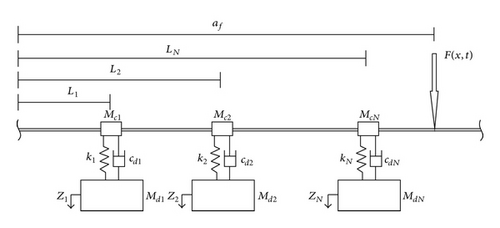
3. Frequency Equation and Mode Shapes
4. Generalized Orthogonality Relations
5. Forced Vibration
6. Numerical Simulation
The sets of parameters employed in the numerical examples are taken from [1, 16]; they are tabulated in Table 1. The validity of the free vibration of the present model is inferred from the results tabulated in Table 2. In the case of a cantilevered beam with three spring-mass-damper systems, the first five natural frequencies of the present model are compared to those of [16]. The results show very good agreement with a maximum error of 0.28%.
| Mode | Cantilevered | Pinned-pinned | ||||
|---|---|---|---|---|---|---|
| 3 spring-mass-damper | 3 spring-mass | 5 spring-mass | ||||
| Reference [16] | Present | Reference [1] | Present | Reference [1] | Present | |
| 1 | − 0.367 ± 25.8769i | − 0.367 ± 25.8544i | 152.7339 | 152.7339 | 150.9571 | 150.9571 |
| 2 | − 0.274 ± 161.7655i | − 0.275 ± 161.9399i | 185.0949 | 185.0949 | 169.4728 | 169.4728 |
| 3 | − 0.031 ± 452.1367i | − 0.031 ± 452.4320i | 247.8313 | 247.8313 | 187.9146 | 187.9146 |
| 4 | − 0.171 ± 887.2157i | − 0.174 ± 887.3469i | 677.5959 | 677.5959 | 217.1278 | 217.1278 |
| 5 | − 0.081 ± 1467.5170i | − 0.082 ± 1468.8356i | 2548.6572 | 2548.6572 | 247.9867 | 247.9867 |
With respect to a pinned-pinned beam with attached three and five spring-mass systems, the validation is done via [1] and shows excellent agreement with four decimal places. The corresponding mode shapes for a beam carrying the three in-span spring-mass systems are depicted in Figure 2. This figure is identical to Figure 3 from [1].
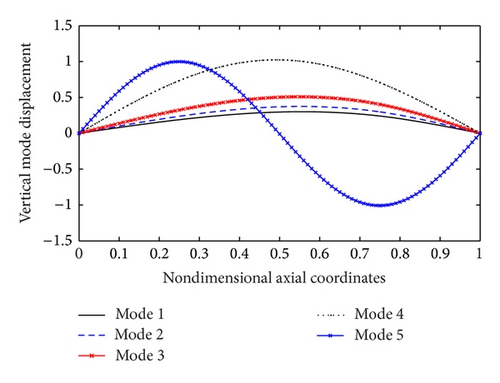
For the forced vibration simulations, an excitation force of F(t) = 10sin(Ωt) is used with zero initial conditions. The force is first applied at the free end of a cantilevered beam with three identical spring-mass-damper systems located at 0.1, 0.5, and 0.9 m from the clamp end. The time history of the vertical displacement of the free end is presented to serve for comparison between the proposed approach (i.e., the combination of the generalized orthogonality conditions with the exact mode shapes of the loaded beam), the finite element method (FEM), and the approach used in [16]. The results are depicted in Figures 3 and 4 for an excitation frequency of 5 and 10 rad/s, respectively. All three methods are in agreement, but the FEM results agree better with the present approach than that of [16].
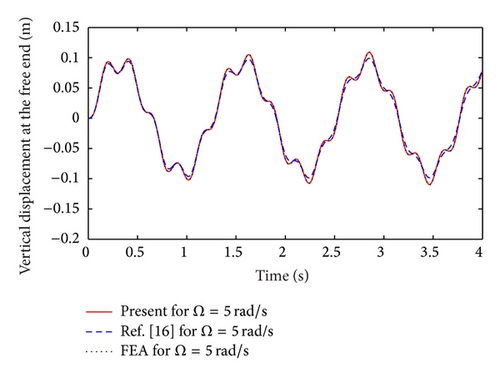
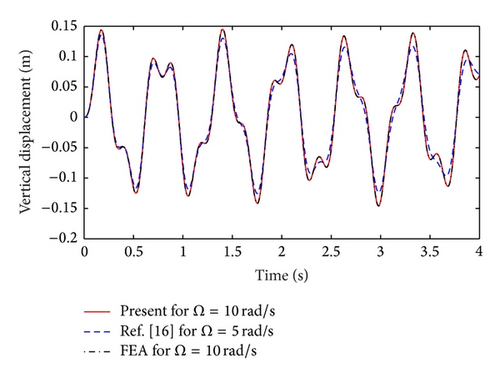
The frequency response curves for a simply supported beam with one in-span mass-spring-damper-mass system attached at 0.1 m from one end using three approaches are depicted in Figure 5. The first approach, which is the most accurate [25], employs the generalized orthogonality conditions along with the mode shapes of the loaded beam. The classical orthogonality relations and the mode shapes of the loaded beam are employed in the second approach, such as in [17–20]. The third method also uses the classical orthogonality conditions, but the mode shapes are those of the bare beam (see [14–16]). All three approaches yield very different midspan vertical displacements. The first approach is the exact solution and hence the error associated with the difference is defined with respect to the first approach. The frequency response amplitude errors are depicted in Figure 6 where the error can be as high as 104.
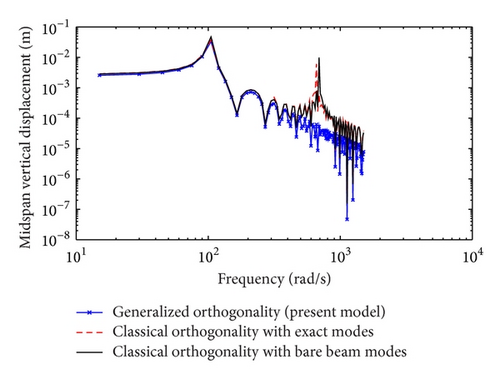
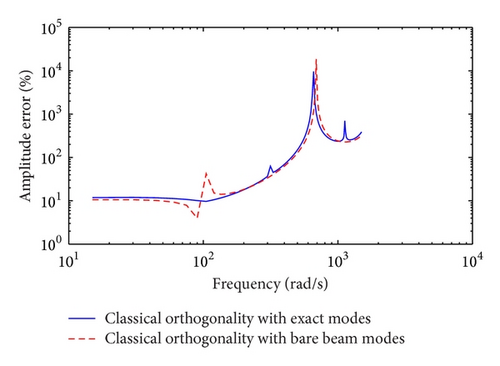
Figure 7 is an identical plot to Figure 5 with the pinned-pinned configuration replaced by a guided-guided one. The corresponding frequency response amplitude error is shown in Figure 8. The maximum amplitude error for the guided-guided beam is higher than that for the simply supported beam. A similar observation with regard to the discrepancy associated with the use of the classical orthogonality was reported in [25] for a simply supported beam carrying a heavy mass. An error as high as 105 was reported.
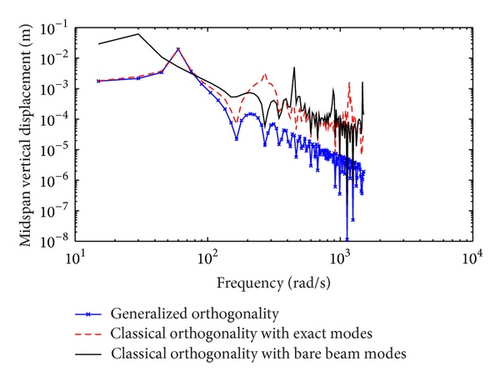
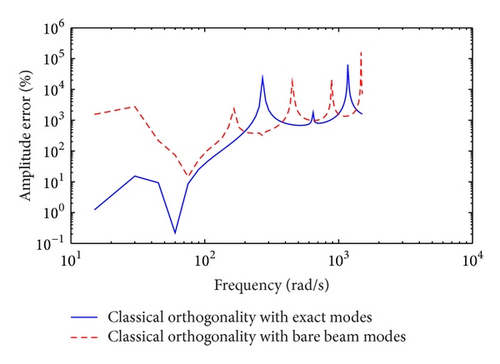
The three approaches are also examined using the parameters taken from [1] for a simply supported beam with one in-span mass-spring-damper system and no tension. Figures 9 and 10 show the frequency response of the midspan displacement for a damping coefficient cdi = 0.1 Ns/m and cdi = 100 Ns/m, respectively. It can be observed that all three methods yield very similar results and the plots are barely distinguishable. The amplitude errors associated with the results presented in Figures 9 and 10 are depicted in Figures 11 and 12, respectively. But for excitation frequencies closer to 600 rad/s the results indicate very minimal error. The discrepancy is more pronounced in the case of the classical orthogonality with the combination of the bare beam mode shapes.

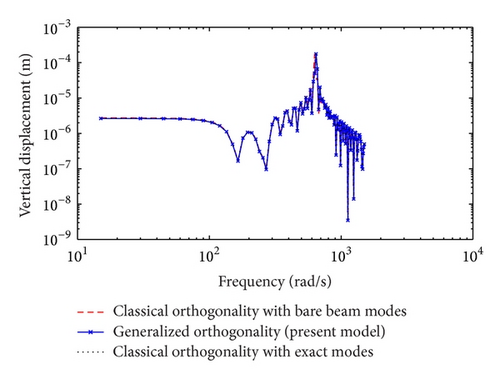
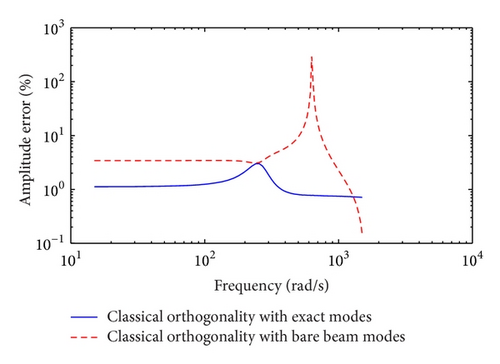

7. Conclusions
A common approach to studying the vibrational response of an elastically loaded beam involves the use of the classical orthogonality relations along with the mode shapes of the bare beam. It has been shown, however, that the mode shapes of the bare beam can be quite different from those of the loaded beam. In the present paper, the exact natural frequencies and mode shapes were presented for an axially loaded beam carrying several vibration absorbers. Explicit expressions were presented for the generalized orthogonality condition. The obtained generalized orthogonality relation was employed along with the assumed modes method to study the forced vibrational response. The numerical simulations indicated that using the common approach could produce erroneous results. The combination of the exact mode shapes of the loaded beam and the corresponding generalized orthogonality relation is necessary for accurate dynamic modeling of a beam carrying elastically mounted masses with dampers.
Conflict of Interests
The authors declare that there is no conflict of interests regarding the publication of this paper.




